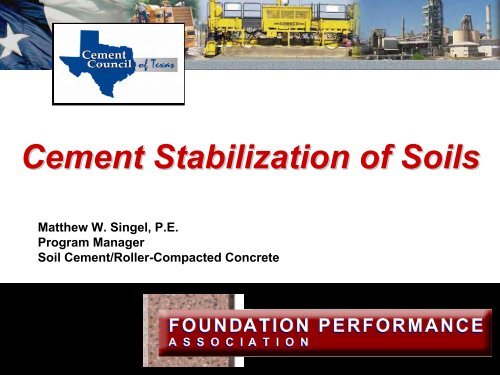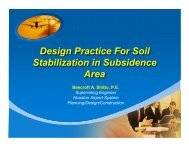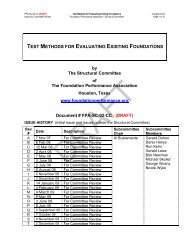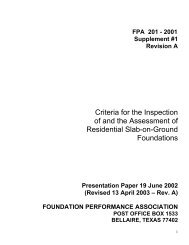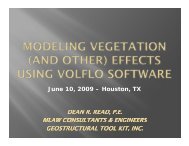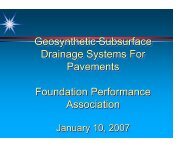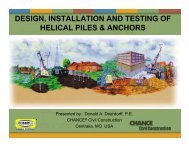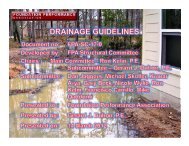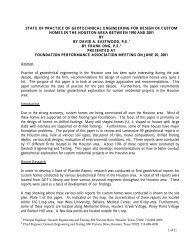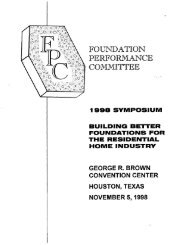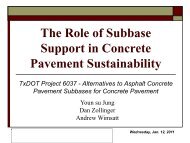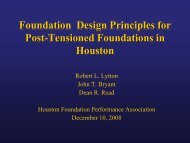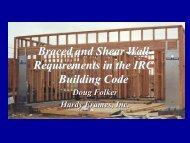Roller Compacted Concrete Pavement: Design and Construction
Roller Compacted Concrete Pavement: Design and Construction
Roller Compacted Concrete Pavement: Design and Construction
Create successful ePaper yourself
Turn your PDF publications into a flip-book with our unique Google optimized e-Paper software.
Cement Stabilization of Soils<br />
Matthew W. Singel, P.E.<br />
Program Manager<br />
Soil Cement/<strong>Roller</strong>-<strong>Compacted</strong> <strong>Concrete</strong>
Cement-Based Cement Based <strong>Pavement</strong><br />
Materials<br />
Cement Content<br />
<strong>Roller</strong>-<strong>Compacted</strong><br />
<strong>Concrete</strong><br />
Soil-Cement<br />
Full-Depth<br />
Reclamation<br />
Cement-Modified<br />
Soil<br />
Cement-<br />
Treated<br />
Base<br />
Rolled<br />
Water Content<br />
Cast<br />
Conventional<br />
<strong>Concrete</strong><br />
No Wearing Course Required<br />
Wearing Course Required<br />
Flowable Fill
<strong>Concrete</strong> <strong>Concrete</strong><br />
Soil--Cement<br />
Soil Cement<br />
Cementitious Gel or Paste<br />
• coats all particles<br />
• fills voids<br />
Hydration Products<br />
• all particles not coated<br />
• voids not filled<br />
• linkages bind soil<br />
agglomerations together
Soil-Cement Soil Cement Materials in a<br />
<strong>Pavement</strong> Section<br />
Cement-Treated Cement Treated Base Base<br />
Full-Depth Full Depth Reclamation<br />
Reclamation<br />
Cement-Modified<br />
Cement Modified Soil<br />
Soil
APPLICATIONS
Reasons to Modify<br />
Improve the properties of the subgrade soil<br />
Reduce volume change caused by moisture<br />
Improve wet strength<br />
Improve compactibility<br />
Expedite construction by improving subgrade<br />
support in wet weather<br />
Eliminate muddy construction sites<br />
Create an all-weather work platform<br />
It is important to remember that<br />
soil modification is different than soil stabilization
<strong>Construction</strong> Problems<br />
with Silts or S<strong>and</strong>y Soils<br />
Fine-grained <strong>and</strong> difficult to compact<br />
Poor gradation<br />
Low bearing capacity<br />
Low cohesiveness <strong>and</strong> shear strength<br />
Unstable under construction equipment
<strong>Construction</strong> Problems<br />
with Clay Soils<br />
High plasticity <strong>and</strong> cohesiveness<br />
Fine-grained <strong>and</strong> poorly graded<br />
High shrink <strong>and</strong> swell potential<br />
Expansive when wet<br />
Low bearing strength when moist<br />
<strong>and</strong> deform under load<br />
Difficult to dry out<br />
Difficult to compact
Solutions for poor subgrade soils<br />
Excavate/replace<br />
with select fill<br />
Aggregate<br />
Soil<br />
Increase the<br />
base/pavement<br />
thickness<br />
Contain using<br />
fabrics or other<br />
geotextiles<br />
Modify soils with<br />
a calcium-based<br />
additive such as<br />
portl<strong>and</strong> cement
BENEFITS
Benefits of Cement-Modified Cement Modified Soil<br />
Small addition of cement to<br />
soils to change properties<br />
Eliminates need for<br />
removal/replacement of<br />
inferior soils<br />
Low cost soil improvement<br />
Improves pavement support<br />
Forms weather-resistant<br />
work platform<br />
Provides permanent nonleaching<br />
modification
By treating the soil with cement,<br />
the detrimental properties of clay<br />
can be improved through the<br />
following three processes:<br />
1. Particle<br />
Restructuring<br />
2. Cement<br />
Hydration<br />
3. Pozzolanic<br />
Reaction
Cement Reactions with Clay<br />
Primary<br />
Ion exchange between calcium in cement<br />
<strong>and</strong> clay which occurs immediately<br />
Secondary<br />
Normal cement hydration contributes to<br />
strength gain
Primary Reaction<br />
Cation exchange reactions occur<br />
Intensifies the grouping of the clay<br />
particles by neutralizing the negative<br />
surface charges<br />
Produces Calcium Hydroxide – Ca(OH) 2 –<br />
(hydrated lime)
Clay particle<br />
Negatively<br />
charged<br />
clay surface<br />
Calcium ions<br />
Cation Exchange<br />
+ _<br />
++<br />
+ + +<br />
+ _<br />
+<br />
+ _<br />
+ _ + _<br />
++<br />
+ _<br />
+<br />
+ +<br />
++ ++ ++<br />
+ _ + _ + _<br />
++<br />
+<br />
+<br />
+ + +<br />
+ _ + +_ _ + _<br />
+<br />
_ _<br />
_<br />
_ +_<br />
+ _<br />
+ _<br />
+ _<br />
+ _<br />
+ _<br />
++<br />
+ _<br />
+_<br />
++<br />
+<br />
+<br />
+ _ + _<br />
+ _<br />
+<br />
++<br />
+ _<br />
+ _<br />
+<br />
+<br />
++<br />
++<br />
+<br />
+<br />
++<br />
+<br />
+ _ + _ + _<br />
+ _<br />
+ _<br />
+_<br />
Sodium ions<br />
Original<br />
spacing<br />
Dipolar H 2 O<br />
Reduced<br />
spacing<br />
after ion<br />
exchange<br />
<strong>and</strong><br />
shrinkage<br />
of water<br />
layer
Particle Restructuring<br />
Unmodified clay particles<br />
Clay particles after<br />
flocculation / agglomeration
Secondary Reaction<br />
Clay participates in the secondary process<br />
Clay is converted to calcium form<br />
Calcium ions combine with dissolved silica<br />
<strong>and</strong> alumina in the clay to create additional<br />
cementitious materials<br />
Strength gain occurs
Cement Hydration<br />
Cement + Water = Calcium Silicate Hydrate<br />
(Cementitious Gel)<br />
- plus –<br />
Calcium Hydroxide<br />
(Hydrated Lime)
Hydration<br />
clay particle<br />
clay-cement<br />
bonds<br />
unhydrated<br />
cement grain<br />
cement hydration products<br />
(CSH <strong>and</strong> CAH)
Pozzolanic Reaction<br />
Hydrated Lime + Silica = Calcium Silicate Hydrate<br />
Hydrated Lime + Alumina = Calcium Aluminate Hydrate<br />
Supplied by<br />
Cement<br />
Hydration<br />
Clay<br />
Minerals<br />
Cementitious<br />
Gel<br />
Note: Without silica or alumina-based clay minerals,<br />
this process does not occur (e.g. s<strong>and</strong>y or silty soils).
Ca(OH) 2<br />
clay particle<br />
(SiO 2 , Al 2 O 3 )<br />
cementitious<br />
material from<br />
pozzolanic<br />
reactions<br />
(CSH <strong>and</strong> CAH)<br />
Pozzolanic Reaction<br />
cementitious<br />
material from<br />
cement hydration<br />
Ca(OH) 2<br />
claycement<br />
bonds<br />
Ca(OH) 2<br />
Ca(OH) 2<br />
calcium hydroxide<br />
from cement
Time of Modification Processes<br />
1. Particle<br />
Restructuring<br />
2.Cement Hydration<br />
3.Pozzolanic Reaction<br />
Immediate<br />
to a few<br />
hours<br />
Largest strength<br />
gain between<br />
1 day <strong>and</strong> 1 month<br />
Slowly, over<br />
months <strong>and</strong><br />
years
DESIGN
Laboratory Tests<br />
Sieve Analysis (ASTM C136)<br />
Atterberg Limits (ASTM D4318)<br />
Moisture-Density (ASTM D558)<br />
Durability Tests<br />
Wet-Dry (ASTM D559)<br />
Freeze-Thaw (ASTM D560)<br />
Soluble Sulfates (ASTM D516)<br />
Compressive Strength (ASTM D1633)
ASTM C136<br />
St<strong>and</strong>ard Test Method<br />
for Sieve Analysis<br />
of Fine <strong>and</strong> Coarse Aggregates
Particle Size<br />
Distribution<br />
Gravel<br />
S<strong>and</strong><br />
Silt<br />
Clay
Hydrometer
ASTM D4318<br />
St<strong>and</strong>ard Test Methods<br />
for Liquid Limit, Plastic Limit,<br />
<strong>and</strong> Plasticity Index<br />
of Soils
Plasticity Index (PI)<br />
The range of moisture through which a soil deforms<br />
under loading<br />
The measure of a soil’s affinity to retain moisture<br />
Plasticity Index is the difference between the<br />
Liquid Limit <strong>and</strong> the Plastic Limit of a soil<br />
PI = LL - PL
Expansive Soils <strong>and</strong><br />
PI Relationships<br />
Degree<br />
Percent<br />
Swell<br />
Approximate<br />
PI<br />
Non-Expansive 2 or less 0 to 10<br />
Moderately<br />
Expansive<br />
Highly<br />
Expansive<br />
2 to 4 10 to 20<br />
More than 4 20 <strong>and</strong> above
ASTM D558<br />
St<strong>and</strong>ard Test Methods<br />
for Moisture-Density Moisture Density Relations<br />
of Soil-Cement Soil Cement Mixtures
St<strong>and</strong>ard Proctor Mold<br />
<strong>and</strong> Rammers
Moisture/Density Relationship
Moisture/Density Relationship<br />
Dry Density (lb/cf)<br />
125<br />
120<br />
115<br />
110<br />
105<br />
100<br />
Maximum Dry Density<br />
5% 7% 9% 11% 13% 15% 17%<br />
Moisture Content<br />
ASTM D558<br />
Optimum Moisture Content
ASTM D559<br />
St<strong>and</strong>ard Test Methods<br />
for Wetting <strong>and</strong> Drying<br />
<strong>Compacted</strong> Soil-Cement<br />
Soil Cement<br />
Mixtures
Wet-Dry Wet Dry Tests<br />
Three cement contents tested<br />
Separate specimens for W-D <strong>and</strong> F-T<br />
St<strong>and</strong>ard Proctors used at optimum moisture<br />
<strong>and</strong> maximum dry density<br />
Moist cured for 7 days
Wet-Dry Wet Dry Tests<br />
Wet-Dry<br />
Soaked in water for<br />
5 hours<br />
Dried at<br />
70°C (158°F)<br />
for 42 hours<br />
Brushed<br />
Repeat 12 times
ASTM D516<br />
St<strong>and</strong>ard Test Method<br />
for Sulfate Ion in Water
0.00% to 0.30% - Sulfate Levels Too Low to be of Concern<br />
0.31% to 0.50% - Sulfate Levels of Moderate Risk<br />
0.51% to 0.80% - Sulfate Levels of Moderate to High Risk<br />
0.81% <strong>and</strong> up - Sulfate Levels of High <strong>and</strong> Unacceptable Risk
ASTM D1633<br />
St<strong>and</strong>ard Test Method<br />
for Compressive Strength<br />
of Molded Soil-Cement<br />
Soil Cement<br />
Cylinders
CMS Strength Determination<br />
The objective of CMS is to amend<br />
undesirable properties of problem<br />
soils or subst<strong>and</strong>ard materials so that<br />
they are suitable for use in<br />
construction. The amount of cement<br />
added to the soil is less than that<br />
required to produce a hardened mass<br />
but is enough to improve the<br />
engineering properties of the soil.<br />
It is important to remember that<br />
soil modification is different than soil stabilization
CTB Strength Determination<br />
Unconfined Compressive Strength Testing<br />
Used by most State DOT’s <strong>and</strong> FAA<br />
Simple <strong>and</strong> quick procedure<br />
7-day strengths ranging<br />
from 300 psi to 800 psi<br />
(2.1 MPa to 5.5 MPa) are<br />
generally recommended<br />
Strengths vary according<br />
to project requirements<br />
300 to 400 psi (2.1 to 2.8 MPa) mixed-in-place<br />
<strong>and</strong> 600 to 800 psi (4.1 to 5.5 MPa) plant mixed
FDR Strength Determination<br />
Unconfined Compressive Strength Testing<br />
ASTM D1633<br />
Used by most State DOT’s <strong>and</strong> the FAA<br />
Simple <strong>and</strong> quick procedure<br />
7-day strengths ranging<br />
from 300 psi to 400 psi<br />
(2.1 MPa to 2.8 MPa) are<br />
generally recommended<br />
Proven strength (support)<br />
under heavy traffic conditions<br />
Proven durability (performance)<br />
in both wet/dry <strong>and</strong> freeze/thaw<br />
environments
Please keep in mind that<br />
strength <strong>and</strong> durability<br />
are NOT the same thing!<br />
The purpose of the<br />
mix design procedure<br />
is to select the<br />
correct additive that<br />
most closely balances<br />
both strength AND<br />
performance for the<br />
roadway materials!
Early Research Involving<br />
Cement-Modified Cement Modified Soils<br />
“Cement Modification of Clay Soils”<br />
A. P. Christensen<br />
Portl<strong>and</strong> Cement Association<br />
1969<br />
Studied the effects of treating clay soils with small amounts<br />
of portl<strong>and</strong> cement<br />
He compared:<br />
Plasticity Index (PI) reduction<br />
shrinkage limits<br />
cohesiveness<br />
unconfined <strong>and</strong> triaxial compressive strengths
Study Soils<br />
Eight were clays, three were clay <strong>and</strong> siltyclay<br />
loams<br />
Four were classification AASHTO A-6<br />
Seven were classification AASHTO A-7-6<br />
The predominant soil used in the study was a<br />
Texas clay (Montmorillonite)<br />
Cement percentages used were 3% <strong>and</strong> 5% by<br />
weight of dry soil
Plasticity Index (%)<br />
50<br />
40<br />
30<br />
20<br />
10<br />
0<br />
Effect of Modification<br />
on Plasticity Index<br />
19<br />
7<br />
4<br />
32<br />
13<br />
10<br />
Soil 2 Soil 5 Soil 9 Soil 10<br />
Untreated 3% Cement 5% Cement<br />
36<br />
22<br />
18<br />
41<br />
33<br />
27
General Results of<br />
Christensen’s Christensen s Study<br />
Portl<strong>and</strong> cement increased the shrinkage<br />
limits of clay soils to values greater than<br />
optimum moisture<br />
Soils with a Plasticity Index (PI) between<br />
18 <strong>and</strong> 29 were reduced to 10 or less after<br />
a 24-hour compaction delay
Current Research Involving<br />
Cement-Modified Cement Modified Soils<br />
•“Tube Suction Test for Stabilized Materials”<br />
•Tom Scullion, P.E.<br />
•Texas Transportation Institute<br />
•2001<br />
•Evaluated the moisture susceptibility of subgrade<br />
soils used in roadway pavements<br />
•Recognized an empirical relationship between<br />
laboratory electrical conductivity values <strong>and</strong><br />
expected performance (durability) of subgrade<br />
materials in the field
Tightly Bound<br />
Loosely Bound<br />
Viscous Water
Tube Suction Test (TST)<br />
for Moisture Susceptibility
Using the Dielectric Probe<br />
dielectric - n. A nonconductor of electricity.
Interpreting TST Results
Dielectric Value<br />
18<br />
16<br />
14<br />
12<br />
10<br />
8<br />
6<br />
4<br />
2<br />
0<br />
Sample Test Data<br />
0 2 4 6 8 10 12<br />
Time (days)<br />
Cement 5.5%<br />
C 3.5% + FA 8%<br />
Cement 7.5%
Summary of Recommended<br />
Laboratory Test Procedure
General Results of the Texas<br />
Transportation Institute’s Institute<br />
Research<br />
A final dielectric value less than 16<br />
appears to be indicative of a stabilized<br />
subgrade material adequately resistant to<br />
moisture susceptibility<br />
Reliable durability predictions can be<br />
made in two-thirds the time of the<br />
conventional W-D <strong>and</strong> F-T Tests
CONSTRUCTION
Subgrades before <strong>and</strong> after CMS
TESTING
Primary Testing Requirements<br />
Gradation Moisture Density<br />
A common gradation<br />
requirement is for<br />
100% to pass the<br />
1.5-inch (38 mm)<br />
sieve <strong>and</strong> a minimum<br />
of 60% to pass the<br />
No. 4 (4.75 mm)<br />
sieve (ASTM C136).<br />
A common moisture<br />
requirement is to be<br />
within 2% of the<br />
laboratory established<br />
optimum moisture<br />
content (ASTM D558).<br />
A common density<br />
requirement is to be<br />
between 95% <strong>and</strong><br />
98% of the<br />
established laboratory<br />
st<strong>and</strong>ard Proctor<br />
density (ASTM D558).
Secondary Testing Requirements<br />
Thickness Stiffness Stability<br />
Requirements for<br />
subgrade depths can<br />
vary from as little as<br />
6 inches (150 mm)<br />
up to 2 feet (0.6 m)<br />
depending on<br />
governing agency.<br />
Measures in-place<br />
engineering values<br />
using structural layer<br />
stiffness, klbf/in<br />
(MN/m) <strong>and</strong> Young’s<br />
Modulus of a material,<br />
kpsi (MPa).<br />
Modified subgrade MUST be<br />
stable before next pavement<br />
course is constructed!<br />
Proof-rolling is the most<br />
commonly accepted practice.
But what about strength?<br />
The objective of CMS is to amend<br />
undesirable properties of problem<br />
soils or subst<strong>and</strong>ard materials so that<br />
they are suitable for use in<br />
construction. The amount of cement<br />
added to the soil is less than that<br />
required to produce a hardened mass<br />
but is enough to improve the<br />
engineering properties of the soil.<br />
It is important to remember that<br />
soil modification is different than soil stabilization
PERFORMANCE
CMS can be used as a subgrade<br />
for either flexible or rigid<br />
pavement structures
The final impact of CMS
Summary:<br />
Cement-Modified Cement Modified Soil<br />
Cement factors normally 2% to 5%<br />
Significant <strong>and</strong> immediate reductions in the<br />
soil’s Plasticity Index<br />
Increases bearing ability of granular or<br />
plastic soils<br />
Produces workable foundation for bases for<br />
both rigid <strong>and</strong> flexible pavements
Summary:<br />
Cement Effects<br />
Strength improves immediately <strong>and</strong> increases<br />
over years<br />
No long-term effects from leaching<br />
Compaction can occur immediately with no<br />
“mellowing period” necessary
Full Full-Depth Full Depth Reclamation<br />
Matthew W. Singel, PE
Full-Depth Full Depth Reclamation<br />
with Cement<br />
• Applications<br />
• <strong>Design</strong><br />
• <strong>Construction</strong><br />
• Testing<br />
• Performance
Definition of Reclamation<br />
Method of flexible pavement reconstruction that<br />
utilizes the existing asphalt, base, <strong>and</strong> subgrade<br />
material to produce a new stabilized base course<br />
for an asphalt, chip seal, or concrete wearing<br />
surface.<br />
Alternative Terms:<br />
Full-Depth Recycling (FDR)<br />
Cement Stabilized Reclaimed Base (CSRB)<br />
Cement Recycled Asphalt <strong>and</strong> Base (CRAB)<br />
Cement Recycled Asphalt <strong>Pavement</strong> (CRA……)
The New Base<br />
The new cement recycled base will be<br />
stronger, more uniform, <strong>and</strong> more<br />
moisture resistant than the original<br />
base, resulting in a long, lowmaintenance<br />
life
Inside a Reclaimer
Soil-Cement Soil Cement Materials in a<br />
<strong>Pavement</strong> Section<br />
Cement-Treated Cement Treated Base Base<br />
Full-Depth Full Depth Reclamation<br />
Reclamation<br />
Cement-Modified<br />
Cement Modified Soil<br />
Soil
Equipment <strong>and</strong> Materials<br />
Recycling vs. New Base<br />
Trucks<br />
(Number)<br />
Material<br />
(tons)<br />
L<strong>and</strong>fill<br />
(cu yd)<br />
Diesel<br />
(gal)<br />
0<br />
12<br />
300<br />
500<br />
1 Mile of 24’-wide 2-lane road,<br />
6” base + 2” asphalt surface<br />
180<br />
4500<br />
2700<br />
3000<br />
New<br />
Recycle
<strong>Pavement</strong> Loadings….<br />
An Increasing Trend
Percent Growth (%)<br />
700<br />
600<br />
500<br />
400<br />
300<br />
200<br />
100<br />
0<br />
1970<br />
Rural Interstates - Growth<br />
1972<br />
1974<br />
1976<br />
1978<br />
Source: Highway Statistics 2000<br />
1980<br />
1982<br />
1984<br />
1986<br />
1988<br />
1990<br />
1992<br />
LOAD<br />
ADT<br />
1994<br />
1996<br />
650%<br />
150%<br />
1998<br />
2000
<strong>Pavement</strong> Distress<br />
Alligator Cracking
<strong>Pavement</strong> Distress<br />
Rutting
<strong>Pavement</strong> Distress<br />
Base Failure
<strong>Pavement</strong> Distress<br />
Moisture Infiltration
<strong>Pavement</strong> Distress<br />
Potholes
Texas <strong>Pavement</strong>s<br />
Miles (x 1000) '<br />
150<br />
100<br />
50<br />
0<br />
Federal<br />
1.0<br />
State<br />
79.0<br />
County<br />
138.0<br />
City/Local<br />
79.0<br />
Centerline Miles of Road<br />
By Jurisdiction<br />
(296,000 Miles)<br />
Composite<br />
6.5%<br />
5.3%<br />
Rigid<br />
88.2%<br />
Flexible<br />
Type of <strong>Pavement</strong>
<strong>Pavement</strong>s in the<br />
United States<br />
<strong>Concrete</strong> <strong>and</strong> Composite<br />
6.6% High Flexible<br />
19.2%<br />
74.1%<br />
Low Flexible<br />
2,450,000 miles of surfaced roads
Reclamation: A Logical Choice<br />
Aging road systems<br />
Most highway systems now in place<br />
Emphasis shifting to<br />
maintenance/rehabilitation<br />
Most roads are local, low-volume,<br />
unpaved or flexible pavements<br />
Possible strategies:<br />
Thick structural overlays<br />
Removal <strong>and</strong> replacement<br />
Reclamation with cement & thin overlay
Applications<br />
Low volume roadways<br />
Residential streets<br />
Medium to high-volume roads<br />
Highways <strong>and</strong> interstates<br />
Airports<br />
Parking lots<br />
Industrial storage facilities
Advantages of Reclamation<br />
Save costs by reusing inplace<br />
materials<br />
Little or no material<br />
hauling<br />
Maintain or improve<br />
existing grade<br />
Conserve virgin materials<br />
Reduce construction time<br />
(quick return to traffic)<br />
Environmentally friendly
Engineering Benefits<br />
• Retards Reflective Cracking<br />
• Increased Rigidity Spreads<br />
Loads<br />
• Eliminates Rutting Below<br />
Surface<br />
• Reduced Moisture<br />
Susceptibility<br />
• Reduced Fatigue Cracking<br />
• Allows Thinner <strong>Pavement</strong><br />
Section
Retards Reflective Cracking
Creates Stable Base<br />
Bonds particles together (increases<br />
strength, stiffness)<br />
Reduces plasticity<br />
Reduces permeability (fills voids, forms<br />
membrane)<br />
Improves compaction (lubrication,<br />
particle restructuring)
Easy <strong>Construction</strong> Process!<br />
<strong>Design</strong><br />
Processing<br />
Compaction<br />
Finishing<br />
Curing<br />
Surfacing
DESIGN<br />
(Preconstruction<br />
Evaluation)
Preconstruction Testing<br />
The procedure includes the following steps:<br />
Site Investigation.<br />
The site should be investigated to determine the cause <strong>and</strong><br />
depth of failure.<br />
Cores or test holes should be used to determine layer<br />
thicknesses <strong>and</strong> to obtain material samples to be recycled<br />
including the asphalt surface, base course aggregate, <strong>and</strong><br />
subgrade.<br />
Lab Evaluation.<br />
Representative samples from the site should be pulverized in<br />
the lab to simulate the aggregate-soil mix anticipated during<br />
construction.
Mix <strong>Design</strong><br />
The mix design procedure uses PCA publication:<br />
Soil Cement Laboratory H<strong>and</strong>book<br />
Includes the determination of:<br />
- maximum dry density,<br />
- optimum moisture content, <strong>and</strong><br />
- compressive strength.<br />
(If unconfined compressive strength is used to<br />
determine cement content, a 7-day strength of<br />
300 to 400 psi is recommended)
Mix <strong>Design</strong> Proportioning<br />
Obtain representative samples of roadway material<br />
Can use up to 50% Reclaimed Asphalt <strong>Pavement</strong> (RAP)<br />
Pulverize to anticipated gradation<br />
100% passing 50 mm (2”)<br />
55% min. passing 6 mm (#4)<br />
Estimate cement content<br />
Usually 4 to 8%<br />
By weight of dry material<br />
Run moisture/density curve<br />
St<strong>and</strong>ard Proctor<br />
(ASTM D558)
Moisture/Density Relationship
Strive for a Balance Between<br />
Strength <strong>and</strong> Performance
Test for Strength<br />
Unconfined Compressive Strength Test<br />
Used by most State DOT’s<br />
Simple<br />
Quick<br />
7-day requirements range<br />
from 200 psi to 800 psi<br />
300 psi to 400 psi is<br />
generally recommended
CONSTRUCTION
Aggregate Adjustment<br />
(if necessary)
Pulverization<br />
Pulverize to required<br />
depth <strong>and</strong> gradation<br />
1 to 4 passes
Material Removal<br />
Excess material can be<br />
removed from roadway<br />
(rare occasions)
Cement Spreading (Dry)<br />
Cement is spread<br />
on top of roadway in<br />
measured amount
Cement Spreading (Slurry)
Blending of Materials<br />
Cement is<br />
blended into<br />
pulverized,<br />
reclaimed<br />
material
Moisture Addition<br />
Water is<br />
added to<br />
achieve<br />
optimum<br />
moisture
Grading<br />
Material is graded<br />
to appropriate<br />
grade, <strong>and</strong> crossslope
Compaction<br />
Material is compacted<br />
96% minimum<br />
St<strong>and</strong>ard Proctor<br />
density
Curing<br />
Water<br />
Bituminous<br />
Compound
Surfacing<br />
Surface course<br />
is applied last<br />
Conventional<br />
<strong>Concrete</strong><br />
<strong>Roller</strong>-<br />
<strong>Compacted</strong><br />
<strong>Concrete</strong><br />
Hot-Mix Asphalt<br />
Surface<br />
Treatment
Typical Recycled Base <strong>and</strong><br />
Surface Thickness<br />
Road Function Typical<br />
Thickness<br />
Recommended<br />
Surface<br />
Residential 6 in 0.75 – 1.5 in<br />
Secondary 8 in 1.5 – 2.5 in<br />
Highway 10 in 2 – 3+ in
Review of <strong>Construction</strong><br />
Procedure<br />
Asphalt<br />
Granular<br />
base<br />
Sub-base<br />
Existing<br />
road<br />
Pulverized<br />
Sub-base<br />
Pulverization<br />
to desired<br />
depth<br />
Pulverized<br />
Sub-base<br />
Removal of<br />
excess material<br />
(if necessary)<br />
<strong>and</strong> shaping<br />
Stabilized<br />
Sub-base<br />
Addition of<br />
additives, mixing,<br />
reshaping <strong>and</strong><br />
compaction<br />
Asphalt<br />
Stabilized<br />
Sub-base<br />
Final surface<br />
treatment
Quality Control<br />
Quality Control<br />
The success of a recycling project<br />
depends upon the careful attention to the<br />
following specified control factors:<br />
pulverization<br />
cement content<br />
moisture content<br />
density<br />
curing
Reflective Cracking<br />
Can it be prevented?
Micro-cracking<br />
Introduces a network of fine<br />
fractures into the base to<br />
mitigate the formation of<br />
major cracks<br />
10-12 ton vibratory roller<br />
applied 1–2 day after<br />
placement<br />
Low Speed<br />
At High Amplitude<br />
2 – 4 passes
PCA Document LT 299
TESTING
Testing<br />
Moisture
Testing<br />
Density<br />
ASTM D 2922<br />
AASHTO T 310
Testing<br />
Thickness
Testing<br />
Stiffness
Testing<br />
Stability
Engineering Benefits<br />
• Retards Reflective Cracking<br />
• Increased Rigidity Spreads<br />
Loads<br />
• Eliminates Rutting Below<br />
Surface<br />
• Reduced Moisture<br />
Susceptibility<br />
• Reduced Fatigue Cracking<br />
• Allows Thinner <strong>Pavement</strong><br />
Section
Retards Reflective Cracking
Increased Rigidity Spreads<br />
Loads<br />
100 psi<br />
15 psi<br />
Unstabilized Granular Base<br />
100 psi<br />
4 psi<br />
Cement-Stabilized Base<br />
• Soil-Cement<br />
• Cement-Treated Base
Eliminates Rutting Below<br />
Surface<br />
Unstabilized Base<br />
Rutting can occur in<br />
surface, base <strong>and</strong><br />
subgrade of unstabilized<br />
bases due to repeated<br />
wheel loading<br />
Cement-Stabilized<br />
Base<br />
Cement-stabilized bases resist<br />
consolidation <strong>and</strong> movement,<br />
thus virtually eliminating rutting<br />
in all layers but the asphalt<br />
surface.
Subgrade Stress (psi)<br />
25<br />
20<br />
15<br />
10<br />
5<br />
0<br />
Subgrade Stress vs. Base Thickness<br />
4 5 6 7 8 9 10 11 12<br />
Base Thickness (in.)<br />
Stone Base<br />
Cement-Treated
Reduced Moisture Susceptibility<br />
High water table<br />
Unstabilized Granular Base Cement-Stabilized Base<br />
Moisture infiltrates base<br />
• Through high water table<br />
• Capillary action<br />
• Causing softening, lower strength,<br />
<strong>and</strong> reduced modulus<br />
Cement stabilization:<br />
• Reduces permeability<br />
• Helps keep moisture out<br />
• Maintains high level of strength<br />
<strong>and</strong> stiffness even when saturated
Reduced Fatigue Cracking<br />
Unstabilized Base<br />
High deflection due to<br />
low base stiffness<br />
Asphalt<br />
Surface<br />
Results in high surface strains<br />
<strong>and</strong> eventual fatigue cracking<br />
Cement-Stabilized<br />
Base<br />
Higher stiffness of<br />
cement-stabilized<br />
base produces lower<br />
deflections<br />
Resulting in lower<br />
surface strains <strong>and</strong><br />
longer pavement life
Asphalt Strain<br />
0.0005<br />
0.0004<br />
0.0003<br />
0.0002<br />
0.0001<br />
0<br />
Asphalt Strain vs. Base Thickness<br />
4 5 6 7 8 9 10 11 12<br />
Base Thickness (in.)<br />
Stone Base<br />
Cement-Treated
Projects
Welcome to Navasota, TX<br />
Population 6,296
“More Bang for the Buck”<br />
Began recycling<br />
program to get<br />
people “out of the<br />
mud”<br />
Has recycled well<br />
over 300,000 SY of<br />
residential streets<br />
2002: 93,000 SY in<br />
20 days.<br />
Ron Akin, Street Superintendent
Rents CMI 425 for<br />
$14,000 ($20,000<br />
w/maintenance<br />
<strong>and</strong> operations).<br />
Mixes 4% cement<br />
Uses city crew<br />
Seal coats<br />
Cost = $1.92/SY<br />
Plans to overlay<br />
recycled streets<br />
w/asphalt.
$22,410 per mile<br />
20 Days<br />
8-hour days<br />
City Crews<br />
City Equipment<br />
Rented CMI<br />
Chip seal<br />
Delaying overlay is working well
FM 1017 Jim Hogg County (2002)<br />
Two $6M contracts<br />
Remove/Replace =<br />
roughly 23 miles vs.<br />
Recycling = 38 miles.<br />
Existing = 22’ wide<br />
hurricane evac route:<br />
2” ACP/8” base
New FM 1017<br />
44 feet wide<br />
12” stabilized subgrade<br />
8” stabilized flexible base<br />
1.5” ACP<br />
One course seal coat applied between<br />
flexible base <strong>and</strong> ACP to facilitate traffic<br />
control <strong>and</strong> to protect against moisture.<br />
Contractors – Ballenger & Foremost –<br />
suggested widening road extra 4 feet for<br />
easier traffic control.
City of Fort Worth
City of Fort Worth FDR<br />
1996: 296 lanemiles<br />
or 2.26<br />
million SY<br />
Spending 60%<br />
of $10-million<br />
budget on<br />
reclamation<br />
Average<br />
material cost:<br />
$1.95 to $2.45<br />
SY
Replace vs Recycle<br />
Full reconstruction =<br />
$278,500 per lane mile<br />
replacing curbs,<br />
gutters, sidewalks &<br />
driveway approaches.<br />
FDR = $200,000, a $78,500<br />
cost-savings.<br />
BUT city keeps 40% to<br />
90% of concrete,<br />
cutting cost to $83,050<br />
per lane mile.<br />
FINAL Cost-savings =<br />
$116,950 lane mile
US 79 Jacksonville<br />
11-mile stretch<br />
8,000 tons of<br />
cement = 4%<br />
333,864 SY<br />
13-in deep
Tarrant County<br />
Reclaiming with cement since 2001.<br />
4.5% cement six to eight inches deep.<br />
Two-inches of asphalt or a two-course<br />
surface treatment tops the roadways.<br />
Material costs = $1.25 - $1.50 per sq. yd.
TxDOT - Amarillo<br />
The Amarillo District recycled a portion of IH-40<br />
pavement with cement<br />
The existing pavement was 11” asphalt <strong>and</strong> 19” of flexible<br />
base<br />
4” of asphalt were removed with a milling machine<br />
The treated base blended 7” asphalt <strong>and</strong> 4” of flex base<br />
A cutback asphalt prime coat was used for curing<br />
The final asphalt surface consisted of a 75 #/sy level-up<br />
layer <strong>and</strong> a 150 #/sy surface
TxDOT - Amarillo<br />
<strong>Construction</strong> process<br />
Two recycling trains were used that included:<br />
Milling machines<br />
Trailer-mounted screening/crushing units<br />
Cold mixing units w/ belt scale <strong>and</strong> liquid additive<br />
systems<br />
Cement was applied by two vane spreading units<br />
The original cement content was specified at 4%<br />
but was lowered to 3-3.5% based on lab tests of<br />
the recycled material
TxDOT - Amarillo<br />
<strong>Construction</strong> process (con’t)<br />
One lane mile per day paved by each train<br />
Project utilized excellent pulverization, mixing,<br />
<strong>and</strong> quality control<br />
A month of construction time was saved<br />
The method was slightly more expensive than other methods<br />
but the time saving was critical<br />
Performance<br />
Highly consistent blended material
Texas DOT Bryan District<br />
On rural FM system<br />
Increased oil field <strong>and</strong> farm traffic<br />
District recycled 10 inches of base<br />
creating a layer<br />
300-400 psi, 4%<br />
Roads were opened to traffic<br />
daily<br />
TTI <strong>Pavement</strong> evaluations of<br />
treated layers include<br />
Stiffness, Cracking, Moisture<br />
Susceptibility <strong>and</strong> performance
Successes<br />
TXDOT – Amarillo – IH-40<br />
NCTCOG - CMS Specification adopted; 100<br />
cities in 16 counties<br />
TXDOT-Tyler - US 69 CMS (2,200 tons)<br />
TXDOT Bryan - Over 500 miles roads (50,000<br />
tons)<br />
TXDOT San Antonio - I-37 S. TX - 18 miles of<br />
recycling (17,000 tons)
Who Is Using It In Texas?<br />
Bedford<br />
Bell County<br />
Dallas<br />
Gr<strong>and</strong> Prairie<br />
Fort Worth<br />
Tarrant County<br />
Goliad County<br />
Bexar County<br />
(Partial List)<br />
Lubbock District<br />
Corpus Christi<br />
District<br />
Bryan District<br />
San Antonio<br />
District
More Advantages<br />
Minimizes inconvenience for both<br />
homes <strong>and</strong> businesses<br />
Less construction equipment<br />
Fast operation<br />
Can apply local<br />
traffic almost<br />
immediately
Base <strong>and</strong> Subbase Materials<br />
100- 0-<br />
70-<br />
60-<br />
% GRAVEL<br />
90-<br />
80-<br />
10-<br />
20-<br />
50-<br />
40-<br />
30-<br />
30-<br />
20-<br />
40-<br />
10-<br />
0-<br />
50-<br />
-100<br />
-90<br />
60-<br />
-80<br />
-70<br />
70-<br />
-60<br />
-50<br />
80-<br />
-40<br />
% SILT <strong>and</strong> CLAY<br />
poor zone for cement<br />
stabilization<br />
% SAND<br />
-30<br />
90-<br />
-20<br />
-10<br />
100-<br />
-0
The BIGGEST Advantage!<br />
Versatility through use of portl<strong>and</strong> cement<br />
Stabilizes many materials<br />
old base<br />
asphalt surface<br />
granular or plastic subgrade<br />
blends<br />
“Portl<strong>and</strong> Cement is probably the closest thing we<br />
have to a universal stabilizer.”<br />
- From a U.S. Army Corps of Engineers Report dated September 2002
for additional information, please visit our website at<br />
www.cement.org/pavements
Web Site:<br />
www.RecyclingRoads .org<br />
New <strong>and</strong> dramatic<br />
Tells all about the recycling process<br />
Describes ongoing <strong>and</strong> completed work<br />
Provides contact information about the owner,<br />
designer, contractor <strong>and</strong> specifics of each job<br />
Provides testimonials by user<br />
Includes “job reports” from each job written up
Thank You!<br />
Matthew W. Singel, P.E.<br />
Cement Council of Texas<br />
cctmatt@earthlink.net<br />
www.RecyclingRoads.org


